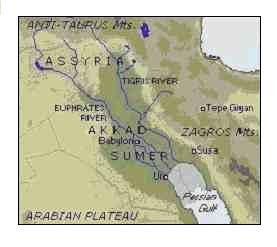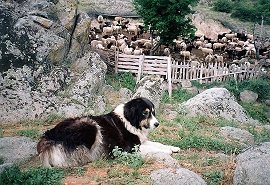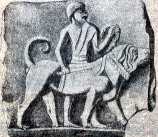|
Karakachan
Karakachansko Kuche, Karakachan Dog, Karakachan Hund |
|
|||||||||||||
|
|
||||||||||||||
|
Shepherds and their dogs. All dogs that generally work with livestock flocks and herds are referred to as herding dogs or shepherd dogs. In some instances, the human shepherd is their partner, but, in other instances, the dog, working alone, is in charge of the flock or herd. Herding dogs actually perform several tasks. Some breeds only muster and drive livestock while others tend and herd, and still others guard. Some breeds perform all necessary shepherding tasks. examples of herding styles and associated dog breedsTask: to muster, fetch and gather from long distances, often using circling - Associated with: Border CollieTask: to tend, boundary patrol and contain in a line - Associated with German Shepherd DogTask: to drive, move and control group from one area to another - Associated with Australian Shepherd livestock guardian dogs Task: to guard, protect and defend, staying with flock at all times, responding aggressively when necessary, working independent of human direction - Associated with Karakachan. This breed was developed at the same time that sheep became domesticated for the purpose of protecting the flock against hungry predators. The behavioural qualities of this livestock guardian dog were most in evidence in areas inaccessible to the human shepherd, thus requiring the dog to think and make decisions on its own as well as act fearlessly. The shepherd could be confident that his dog would keep his sheep safe under all circumstances. In the modern Karakachan, these instincts are still present and strong. |
|
|||||||||||||
|
Mesopotamia The genesis of the livestock guardian dog can not be separated from our own human and social development. The geographical birthplace of the original livestock guardian dog is the same as our own earliest civilizations, located in the region known as the Fertile Crescent. |
 |
|||||||||||||
|
The domestication of dogs and their resulting specialized functions in relation to farming and livestock breeding started at the bank of the Euphrates River, extending to the edge of the mountains surrounding the Mesopotamian plain. Archaeological excavations and native arts and crafts found in the Caucasus, the shore of the Caspian Sea, along the banks of the Don and the Dnjepr Rivers, and the Krim peninsula leading into the Black Sea provide evidence of the important livestock guardian dog. Livestock was particularly important in the Anatolian and Kurdian mountainous areas, where the quality and quantity of annual harvests were compensated by the breeding of cattle, which supplied not only dairy and meat products for humans but also fertilizer for cultivated plants and crops. |
||||||||||||||
|
||||||||||||||
|
Has probably been bred in the area of present-day Bulgaria for 5000 years. It
is large (65-75 cm at the shoulders for males and 60-68 cm for females),
with |
||||||||||||||
|
||||||||||||||
|
©
2005 Semperviva
|




